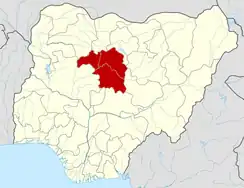Jema'a
Jema'a (also written Ajemaa and Jama'a) is a Local Government Area in southern Kaduna State, Nigeria with headquarters at Kafanchan. The Local Government Council is chaired by Yunana Barde.[2] It has an area of 1,384 km2 and a population of 278,202 at the 2006 census.[3] The postal code of the area is 801.[4]
Jema'a
Ajemaa Jama'a | |
|---|---|
LGA and Town | |
Clockwise from top: Entrance, Jemaa LGA Secretariat, Kafanchan • A Bust of Patrick Yakowa, Kafanchan• Jemaa LGA Secretariat | |
| Country | |
| State | Kaduna State |
| Headquarters | Kafanchan |
| Government | |
| • Type | Democracy |
| • Executive Chairman | Yunana Barde |
| Area | |
| • Total | 534 sq mi (1,384 km2) |
| Population (2006) | |
| • Total | 278,202 |
| • Density | 703/sq mi (271.4/km2) |
| 2006 National Census | |
| Time zone | UTC+1 (WAT) |
| ISO 3166 code | NG.KD.JE[1] |
Geography
Landscape
Jema'a Local Government Area lies on a broad low - lying topography with gently rolling plains on either side. it is flanked by two rivers.[5] To the northwestern side of the area is the Amere or Mada river popularly referred to as River Wonderful by the people because it has claimed many lives including those of some of the colonial engineers during the rail bridge construction at Aduwan (another bridge build on the same river during the British colonial era exists near Kogum River Station).[6][7] The second river to the southeast is the Sanga (or the Kogum River) sourced from the plateau. Both rivers merge close to the Kogum River Station. There lie in addition, numerous hills, valleys streams. The undulating lands also provide fertile grounds for agricultural activities.[8]
Government and politics
Boundaries
Jema'a Local Government Area (LGA) shares boundaries with Zangon Kataf LGA to the north, Jaba LGA to the west, Sanga LGA to the east, Kaura LGA to the northeast; Riyom LGA of Plateau State to the east and Karu LGA of Nasarawa State to the south respectively.[9][10]
Administrative subdivisions
Jema'a Local Government Area consists of 12 subdivisions (second-order administrative divisions) namely:[11]
- Asso
- Atuku
- Barde
- Gidan Waya (formerly Jema'a)
- Godogodo
- Jagindi
- Kafanchan A
- Kafanchan B
- Kagoma (Gwong)
- Kaninkon (Nikyob)
- Maigizo (Kadajya)
- Takau
Demographics
People
Jema'a Local Government Area consist of a number of related ethnic groups and subgroups as well as a migrant population from other parts of the country, especially in the Local Government Area headquarters of Kafanchan (Fantswam) and the towns of Jema'a, Dangoma and Jagindi where the migrating Fulani population from Kajuru were accepted by the locals and settled in the early 19th century.[12]
The ethnic groups and subgroups in Jema'a LGA include: Atyuku (Atuku), Fantswam, Gwong, Nikyob, Nindem and Nyankpa.[13] Others are: Atyap, Bajju, Berom, Fulani, Hausa, Ham, Igbo and Yoruba.[14]
Population
According to the March 21, 2006 national population census, Jema'a (Ajemaa) had a population of 278,202. Its population was projected by the National Population Commission of Nigeriahttps://nationalpopulation.gov.ng/ and National Bureau of Statistics to be 375,500 by March 21, 2016.
Economy
The people of the local government are predominantly farmers, cultivating cash crops such as cotton, peanuts and ginger; and food crops such as corn, millet and sorghum in subsistent qualities.[15] There is also an old tin mining tunnel site in the town of Godogodo.
Notable people
- Joseph Bagobiri, First Bishop of Catholic Diocese Kafachan and clergy [16]
- Musa Didam, paramount ruler
- Joe El, singer, songwriter
- Josiah Kantiyok, consultant, paramount ruler
- Victor Moses, footballer
- Patrick Yakowa, former state governor
- Luka Yusuf, military service
References
- HASC, population, area and Headquarters Statoids
- "Kaduna LG Polls: APC humbles PDP, wins 15 chairmanship seats". 2021-09-07. Retrieved 2022-03-16.
- "Kaduna State of Nigeria". City Population. Retrieved September 26, 2020.
- "Post Offices- with map of LGA". NIPOST. Archived from the original on 2009-10-07. Retrieved 2009-10-20.
- Meek, C.K (1925). The northern Tribes of Nigeria: an Ethnographical account of the Northern provinces. london: Oxford University press.
- Schwarz, F.A.O (1965). Nigeria: The Tribes, the Nation or Rice, the politics of independence. Cambridge: The M.I.T Press.
- Simon, Y. (1982). "Southern Zaria in Historical perspective". departmental seminar, History department of Ahmadu Bello University, Zaria.
- Kaduna State: Everyone's Handbook. Kano, Nigeria: Triumph Publishing Company Ltd. 1982. p. 29. ISBN 978-188-006-6.
- "Latest violence in Southern Kaduna Longest on record - Report". Premium Times Nigeria. February 12, 2017. Retrieved August 1, 2020.
- "Kaduna-State-Political-Map". VON. Retrieved August 7, 2020.
- "Jema'A, Kaduna State, Nigeria". Retrieved September 25, 2020.
- Afuwai, Yanet. The Place of Kagoro in the History of Nigeria.
- "Districts and Village Units of Kaduna State". Retrieved August 6, 2020.
- "Emir of Jama'a celebrates 20 years on throne". Daily Trust. 2018-12-09. Retrieved 2023-05-22.
- "Jemaa, Nigeria". Retrieved August 6, 2020.
- Catholic hierarchy
External links
- List of Towns and Villages in Jema'a LGA on Nigeria ZIP codes
- Rural Areas in Jema'a L.G.A. on Postcodes.NG
![]() Media related to Jema'a at Wikimedia Commons
Media related to Jema'a at Wikimedia Commons



